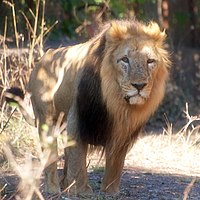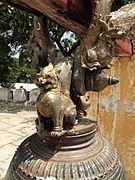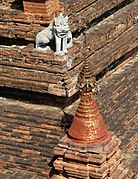art.wikisort.org - Sculpture
Chinthe[lower-alpha 1] (Burmese: ခြင်္သေ့ (IPA: [tɕʰɪ̀ɰ̃ðḛ]); Mon: ဇာဒိသိုၚ် ([cɛ̀atìʔsaŋ]); Shan: သၢင်ႇသီႈ ([sàːŋ si])) is the Burmese word for 'lion'.[2][3] The leograph[4][5] of Chinthe is a highly stylized lion[6][7] commonly depicted in Burmese iconography and architecture, especially as a pair of guardians flanking the entrances of Buddhist pagodas and kyaung (or Buddhist monasteries).

![Two lions guard the entrance to Shwedagon Pagoda[1]](http://upload.wikimedia.org/wikipedia/commons/thumb/1/16/Chinthe.JPG/220px-Chinthe.JPG)
Natural lion

In contrast to popular foreign beliefs, the Chinthe is not a mythical creature[8] but instead an entirely natural lion,[9] although often associated with Buddho-Burmese myths.
The Burmese leograph[10] is related to other stylized lions in the Asian region, including the sing (สิงห์) of Thailand, Cambodia, Laos, and the simha (සිංහ) of Sri Lanka, where it is featured prominently on the Sri Lankan rupee. It is also related to East Asian leographs, such as the guardian lions of China, komainu of Japan, shisa of Okinawa and Snow Lion of Tibet.
Origins
The story of why the lions guard the entrances of pagodas and temples is given in the Mahavamsa:
The princess Suppadevi of Vanga Kingdom (present day Bengal) had a son named Sinhabahu through her marriage to a lion, but later abandoned the lion who then became enraged and set out on a road of terror throughout the lands. The son then went out to slay this terrorizing lion. The son came back home to his mother stating he slew the lion, and then found out that he killed his own father. The son later constructed a statue of the lion as a guardian of a temple to atone for his sin.[11]
In Burmese culture
The leograph[10] of Chinthe appears as an element of Burmese iconography on many revered objects, including the palin (Burmese royal throne) and Burmese bells.[13]
Predating the use of coins for money, brass weights cast in the shape of iconic animals like the Chinthe were commonly used to measure standard quantities of staple items.[14]
In the Burmese zodiac, the lion sign is representative of Tuesday-born individuals.[15]
The leograph is featured prominently on the successive post-independence State seals (including the current State Seal of Myanmar) and most paper denominations of the Burmese kyat, and its statues are found as guardian statues of most pagodas and temples.
Gallery
- Leographic statues[16] line the rooftop at Bagan's Ananda Temple
- Close-up of the stylized lion head,[17] Ananda Temple
- Temple bell in Bagan, Myanmar
- Lion statue on Dhammayazika Pagoda, Bagan, Myanmar
- A pair of whitewashed lions[13] guard the entrance to Mandalay Hill
- Chinthe of So Hla Waing in Bagan, Myanmar
- Chinthe atop the Mingun Bell[13]
Relation to Second World War Chindits
During the Second World War, the British Brigadier Orde Wingate was given command of forces charged with long-range penetration operations behind Japanese lines in Burma. At the suggestion of Captain Aung Thin of the Burma Rifles, Wingate decided to call this force "The Chinthes" (The Lions),[18] a name which became corrupted to "The Chindits" and was so recorded in the annals of World War II.[3]
See also
- Asiatic lion
- Chinese guardian lions
- Shisa
- Shishi
- Singh
- Lion dance
Notes
- ခြင်္သေ့
- MLCTS: hkrangse.
- ALA-LC: khraṅse′
- BGN/PCGN: chinthe / chinthayt
References
- Shwedagon, Symbol of Strength and Serenity. Yangon, Burma: Yangon City Development Committee. 1997. p. 25.
- Myanmar-English Official Dictionary. Yangon, Burma: Department of the Myanmar Language Commission. 1993. p. 79.
- United States, Congress (1945). Hearings. Washington, USA: U.S. Government Printing Office. p. 3.
- Archaeological Department of Burma (1902). Report on Archaeological Work in Burma. Yangon, Burma: Superintendent, Government Printing. p. 22.
- Session, I.A.H Congress (1996). Proceedings of the 4th Session of Indian Art History Congress. Virginia, USA: University of Virginia. p. 100.
- Arts of Asia: Volume 35, Issues 1-2. Virginia, USA: AOA Publications. 2005. p. 111.
- Ralph Isaacs, T.Tichard Blurton (2000). Visions from the Golden Land: Burma and the Art of Lacquer. Landon, England: British Museum. p. 169. ISBN 9780714114736.
- Sergei Sergeevich Ozhegov, Irene Moilanen (1999). Mirrorred in Wood: Burmese Art and Architecture. White Lotus Press. p. 67. ISBN 9789747534009.
- Bunyard, Britt A. (2000). Walking to Singapore: A Year off the Beathen Path in Southeast Asia. U.S.A: Writers Club Press of iUniverse. p. 401. ISBN 9781469772981.
- Southeast Asia Handbook. Michigan, USA: Moon Publications. 1994. p. 91. ISBN 9781566910026.
- "Image 5 of 20". myanmar-image.com. Archived from the original on 2017-04-11. Retrieved 2010-09-17.
- Burma, Information and Broadcasting Department (1948). Burma's Fight for Freedom: Independence Commemoration. Yangon, Burma: Superintendent, Government Print. and Stationery. p. 119.
- Dr., Tin Mg Oo (2005). Aspects of Myanmar Culture. Yangon, Burma: Cho-Tay-Than Bookhouse. p. 28.
- Shwechinthe Birmans[permanent dead link]
- Sir., James George Scott (1882). The Burman: His Life and Notions, Volume 2. London, England: Macmillan and Company. p. 94.
- The Atlas of Dream Places: A Grand Tour of the World's Best-loved Destinations. Konecky & Konecky. 2002. p. 214. ISBN 9781568523576.
- Majumdar, Ramesh Chandra (1960). Ancient India. Delhi, India: Motilal Banarsidass (MLBD). p. 497.
- Duckworth, L.B (1945). Your Men in Battle: The Story of the South Staffordshire Regiment- 1939-45. Michigan, USA: Express and Star. p. 17.
На других языках
- [en] Chinthe
[it] Chinthe
La Chinthe è una creatura mitologica[1] simile al leone, che è situata alle entrate delle pagode o i templi in Birmania (stupe). La Chinthe serviva a proteggere la stupa. Si tratta dalla locale evoluzione del leone guardiano tipico della Cina.Другой контент может иметь иную лицензию. Перед использованием материалов сайта WikiSort.org внимательно изучите правила лицензирования конкретных элементов наполнения сайта.
WikiSort.org - проект по пересортировке и дополнению контента Википедии


![Leographic statues[16] line the rooftop at Bagan's Ananda Temple](http://upload.wikimedia.org/wikipedia/commons/thumb/9/90/Bagan-Ananda-220-Chinthes-gje.jpg/270px-Bagan-Ananda-220-Chinthes-gje.jpg)
![Close-up of the stylized lion head,[17] Ananda Temple](http://upload.wikimedia.org/wikipedia/commons/thumb/6/61/Bagan_2019_10.jpg/120px-Bagan_2019_10.jpg)


![A pair of whitewashed lions[13] guard the entrance to Mandalay Hill](http://upload.wikimedia.org/wikipedia/commons/thumb/6/6a/Chinthes_guarding_Mandalay_Hill.JPG/240px-Chinthes_guarding_Mandalay_Hill.JPG)

![Chinthe atop the Mingun Bell[13]](http://upload.wikimedia.org/wikipedia/commons/thumb/8/8a/Suspension_of_the_Mingun_Bell.jpg/120px-Suspension_of_the_Mingun_Bell.jpg)